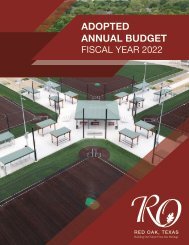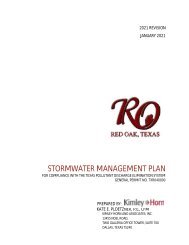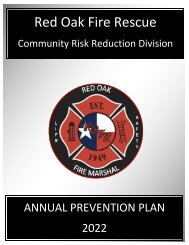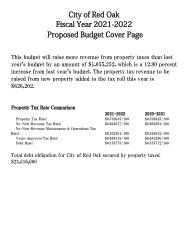Annual Comprehensive Financial Report 2021
Create successful ePaper yourself
Turn your PDF publications into a flip-book with our unique Google optimized e-Paper software.
D. Cash, Deposits and Investments<br />
The City's cash and cash equivalents are considered to be cash on hand, demand deposits and shortterm<br />
investments with original maturities of three months or less from the date of acquisition.<br />
The Economic Development Corporation and Industrial Development Corporation are authorized by<br />
their governing boards to invest in obligations of the U.S. Treasury and local government investment<br />
pools (TexPool and LOGIC).<br />
Investments in government pools are recorded at amortized cost. All other investments are recorded<br />
at fair value. Fair value is the amount at which a financial instrument could be exchanged in a<br />
current transaction between willing parties.<br />
E. Receivables and Payables<br />
Activity between funds that are representative of lending/borrowing arrangements outstanding at<br />
the end of the fiscal year are referred to as either "due to/from other funds" (i.e., the current portion<br />
of inter-fund loans) or "advances to/from other funds" (i.e., the non-current portion of inter-fund<br />
loans). All other outstanding balances between funds are reported as "due to/from other funds."<br />
Any residual balances outstanding between the governmental activities and business-type activities<br />
are reported in the government-wide financial statements as "internal balances."<br />
Advances between funds, as reported in the fund financial statements, are offset by a fund balance<br />
reserve account in applicable governmental funds to indicate that they are not available for<br />
appropriation and are not expendable available financial resources.<br />
All trade and property tax receivables are shown net of an allowance for uncollectibles. Trade<br />
accounts receivables in excess of sixty days comprise the trade accounts receivable allowance for<br />
uncollectibles. The property tax receivable allowance is based on historical collection experience.<br />
The City's property tax is levied each October 1 on the assessed value listed as of the prior January<br />
1 for all real and personal property. Appraised values are established by the Ellis Central Appraisal<br />
District as market value and assessed at 100% of appraised value. Property taxes attach as an<br />
enforceable lien on property as of January 1. The Ellis County Tax Assessor/Collector bills and<br />
collects the City's property taxes, which are due October 1. Full payment can be made prior to the<br />
next January 31 to avoid penalty and interest charges. Overtime, substantially all property taxes<br />
are collected.<br />
F. Inventories and Prepaid Items<br />
All inventories are valued at cost using the first-in/first-out (FIFO) method. Inventories are recorded<br />
as expenditures when consumed rather than when purchased.<br />
Certain costs applicable to future accounting periods are recorded as prepaid items. The cost of<br />
prepaid items is recorded as expenditures/expenses when consumed rather than when purchased.<br />
G. Restricted Assets<br />
Certain proceeds of the City's enterprise fund revenue bonds, as well as certain resources set aside<br />
for their repayment, are classified as restricted assets on the statement of Net Position because they<br />
are maintained in separate bank accounts and their use is limited by applicable bond covenants.<br />
The "revenue bond construction" account is used to report those proceeds of bond issuances that<br />
are restricted for use in construction. The "interest and sinking" account is used to segregate<br />
resources accumulated for debt service payments over the next twelve months.<br />
H. Capital Assets<br />
Capital assets, which include property, plant, equipment and infrastructure assets (e.g., roads,<br />
bridges, curbs and gutters, streets and sidewalks, drainage systems and lighting systems), are<br />
reported in the applicable governmental or business-type activities columns in the government-wide<br />
financial statements. Capital assets are defined by the City as assets with an initial, individual cost<br />
of more than $5,000 and an estimated useful life in excess of one year. Such assets are recorded<br />
at historical cost or estimated historical cost If purchased or constructed. Donated capital assets are<br />
recorded at estimated acquisition value.<br />
26
















